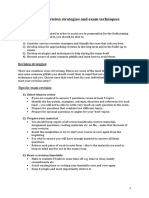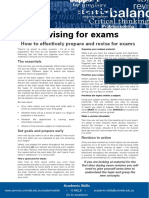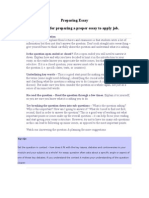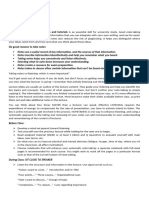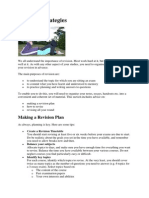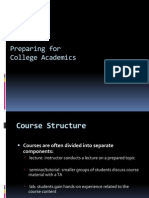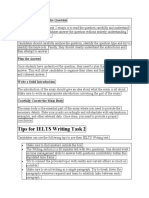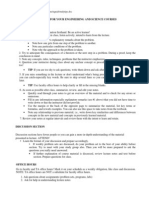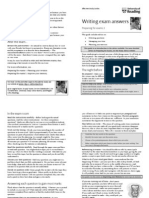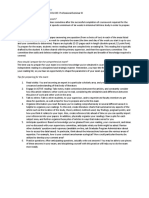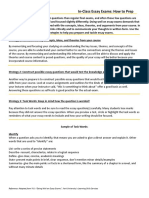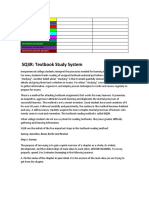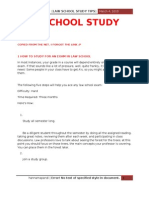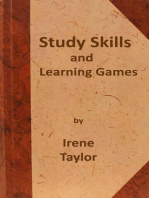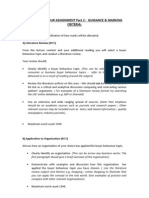Case Study Exams
Case Study Exams
Uploaded by
Tz SenCopyright:
Available Formats
Case Study Exams
Case Study Exams
Uploaded by
Tz SenOriginal Title
Copyright
Available Formats
Share this document
Did you find this document useful?
Is this content inappropriate?
Copyright:
Available Formats
Case Study Exams
Case Study Exams
Uploaded by
Tz SenCopyright:
Available Formats
www.qut.edu.
au QUT Library
Case Study Exams
ase study exams are designed to enable students to show how they can apply their knowledge and understanding of a subject in a real life scenario. Such exams often ask you to solve a problem using your knowledge of the subject.
Take notes of the main points and their links to other aspects of the subject. Understanding involves not only being able to remember facts and ideas but also being able to explain the connections between them, often through the use of examples.
Rewrite
After attending classes and reading the assigned material each week, you need to rewrite the ideas in your own words. Use text, diagrams or concept maps to make the ideas memorable. A suggestion for rewriting is set out in the table below.
Main Idea/ Topic/ Theme/ Explanation in your own words Example of how, when, where, why can/do I apply this? Connec -tions to other topics References relevant to the topic
Preparation for the exam
In-depth understanding of any subject takes time to develop. This is why lecturers expect you to build knowledge by reading, revising and taking notes throughout the semester rather than cramming everything at the end. Our brains need time to process, to incubate our understanding. Here are some study tips to make your study much easier when it comes to exam time.
Attend
Turn up to classes, particularly the first and last lectures when it is most likely that the lecturer will talk about what will be on the exam. Actively participate do the readings before class, listen, take notes, ask questions about the things you do not understand.
Chunk
When the time comes for you to revise for your exams you need to summarise all the information you have collected over the semester. Chunking means to summarise large amounts of information into smaller, connected chunks. These chunks provide headings and summary information to help you link back to more complex ideas. You need to develop an overview of all the topics which may be on the exam and an understanding of how they link together.
Read
Keep up with your readings each week. If you cannot get through all the weekly readings at least make sure you do some. Skimming is a quick method of reading that creates an overview of material. (Refer to Studywell > Reading and Notetaking > Fast Reading Techniques). Do not wait until the end of semester to read.
Sitting the Exam
Read the questions first
Case study exams often include a scenario and then a list of questions at the end. If your exam is this type, then read the questions before you read the scenario so that you know what information you need to focus
Open Book Exams
www.qut.edu.au QUT Library on. Some scenarios include a lot more information than you will need to answer the questions. Use evidence from both the scenario and your knowledge of the subject to back up your points. The more you integrate your readings from the semester, the more likely you are to do well. Consider counterarguments to your solutions in your answer. Provide reasons why these counterarguments are not successful.
Read the scenario carefully so you dont miss any vital details. Read once for an overview. Twice to clarify details Read the scenario carefully
Read the scenario carefully. It is easy to miss vital details that are important in your solution to the problem posed. Read the scenario once to get an overview of the case. As you read it you should underline key points or put notes in the margins as you go. Skim the scenario again each time you answer a question. Use a different coloured pen to highlight sections of the case relevant to particular questions.
Leave time to edit
Allow enough time to edit your answers before finishing your exam. It is likely that you forgot an important detail, found better evidence or clearer words by the time you finish your first draft.
1. Rearrange paragraphs with arrows or alphabetic or numeric symbols to indicate order, so that the marker can easily follow your ideas.
A B C
2. Cross out words you do not want with a clear line through the top middle. evidence 3. Insert new information for your answer above text you have already written with a caret (^).
Answer questions carefully
Make sure you allocate time for each question so that you dont use too much time on one question and then have to rush others. Use double-spacing or small writing to write your answers. Write the main answer of each question in the first sentence using the same words as the question asked. Ensure that you not only provide the solution to the problem but you also explain why this is correct. PHOTO REFERENCE 'student in classroom reading, long brown hair ', In: http://www.shropshire.gov.uk/res.nsf/ A5D019A32FB1A7C7802573370032A1AB/$file/studen t.jpg, ed, 2009, student in classroom reading. Ross Websdale, 'Coloured Pens', In: http://www.flickr.com/photos/rosswebsdale/281980 1717/, ed, 2008, Coloured pens.
Open Book Exams
You might also like
- Short Answer and Essay QuestionsDocument4 pagesShort Answer and Essay Questionsmonali raiNo ratings yet
- Advance Taxation Refresher CourseDocument92 pagesAdvance Taxation Refresher Coursemunira sheraliNo ratings yet
- Advance Taxation Refresher Course - MMHDocument92 pagesAdvance Taxation Refresher Course - MMHOmerNo ratings yet
- Guide To Revision Strategies and Exam TechniquesDocument3 pagesGuide To Revision Strategies and Exam TechniquesjennywrenwattsNo ratings yet
- How To Take Notes.185103820Document5 pagesHow To Take Notes.185103820Tara_VanGeonsNo ratings yet
- Good Essay Writing Tips: What Do Examiners Look For?Document4 pagesGood Essay Writing Tips: What Do Examiners Look For?DrShailendra PatelNo ratings yet
- Government College University Faisalabad: 1.1 Importance of Note TakingDocument21 pagesGovernment College University Faisalabad: 1.1 Importance of Note TakingSyed Ali Waqar HashmiNo ratings yet
- How To Study ChemistryDocument3 pagesHow To Study ChemistryRSL0% (1)
- How To Take Notes From A Lecture or Reading: Don't Use Your LaptopDocument3 pagesHow To Take Notes From A Lecture or Reading: Don't Use Your LaptopJeremy Steffy100% (1)
- Essays - Writing in ExamsDocument5 pagesEssays - Writing in ExamsCorinne BaldwinNo ratings yet
- How To Be Ready For ExamDocument6 pagesHow To Be Ready For ExamDej AdmasuNo ratings yet
- Manage Time & SourceDocument5 pagesManage Time & SourcePANNEERNo ratings yet
- Examination Skills 101Document19 pagesExamination Skills 101pennylopemakumbaneNo ratings yet
- Revising For Exams Update 051112 PDFDocument2 pagesRevising For Exams Update 051112 PDFJason MannNo ratings yet
- Study SkillsDocument4 pagesStudy Skillsmailadityap921No ratings yet
- Taking Notes: Joko HendartoDocument27 pagesTaking Notes: Joko HendartoRakyat Kecil BerdasiNo ratings yet
- Preparing Essay Those Steps For Preparing A Proper Essay To Apply JobDocument3 pagesPreparing Essay Those Steps For Preparing A Proper Essay To Apply JobirfannofaNo ratings yet
- English 100 PDF MidtermnotesDocument8 pagesEnglish 100 PDF MidtermnotesJohn PinoyNo ratings yet
- Assesment Writing - Advice and GuidanceDocument7 pagesAssesment Writing - Advice and GuidanceKelsoNo ratings yet
- Writing Essays: Analysing The Essay QuestionDocument4 pagesWriting Essays: Analysing The Essay QuestionHarish KhatriNo ratings yet
- How To Write A Good Answer To Exam Essay Questions - 13 StepsDocument5 pagesHow To Write A Good Answer To Exam Essay Questions - 13 StepsNUR AFIFAH BINTI JAMALUDIN STUDENTNo ratings yet
- Study Skills Assignment (Notetaking Strategies)Document8 pagesStudy Skills Assignment (Notetaking Strategies)Saba KiranNo ratings yet
- How To Prep For MNGDocument4 pagesHow To Prep For MNGNhi HoNo ratings yet
- SQR4 MethodDocument2 pagesSQR4 MethodariNo ratings yet
- Essay Writing in SchoolsDocument3 pagesEssay Writing in Schoolsdeedam tonkaNo ratings yet
- Tips Essential For Cramming Part 1Document4 pagesTips Essential For Cramming Part 1Olaniyi EvansNo ratings yet
- Revision Strategies: Making A Revision PlanDocument4 pagesRevision Strategies: Making A Revision PlanAshwani RanaNo ratings yet
- Examiner-Approved IELTS Tips: ListeningDocument4 pagesExaminer-Approved IELTS Tips: Listeningriyadhbd_ctgNo ratings yet
- Preparing For College AcademicsDocument21 pagesPreparing For College AcademicscgdelongNo ratings yet
- Essay Structure 22 23Document11 pagesEssay Structure 22 23Teo PhiriNo ratings yet
- Taking Effective Notes: Dr. Idna M. Corbett Learning Assistance and Resource Center West Chester UniversityDocument22 pagesTaking Effective Notes: Dr. Idna M. Corbett Learning Assistance and Resource Center West Chester Universitylal_free2rhyme100% (4)
- Tips For IELTS Writing Task 2: Read and Understand The QuestionDocument2 pagesTips For IELTS Writing Task 2: Read and Understand The QuestionGia GiaNo ratings yet
- Writing University Essays by ProfessorDocument5 pagesWriting University Essays by ProfessorzafarNo ratings yet
- Study Tips Engineering ScienceDocument4 pagesStudy Tips Engineering SciencekhannawazNo ratings yet
- The Sq3R MethodDocument3 pagesThe Sq3R MethodMuhammadKhizarSiddiqueNo ratings yet
- Open Book TestDocument35 pagesOpen Book TestTanNo ratings yet
- Writing Exam Answers: What Not To Write!Document2 pagesWriting Exam Answers: What Not To Write!Omar SeeriaNo ratings yet
- Reading For UnderstandingDocument4 pagesReading For Understandinglexjoseph78No ratings yet
- Subject-Why I Chose AccountsDocument16 pagesSubject-Why I Chose AccountsLazaro HengaNo ratings yet
- Tips For Comprehensive ExamsDocument2 pagesTips For Comprehensive ExamsMirasol SedilloNo ratings yet
- Studyandthinkingskillsinenglish 091020094244 Phpapp01Document148 pagesStudyandthinkingskillsinenglish 091020094244 Phpapp01FrancisEmmanuelGonzagaNo ratings yet
- Tips To Ace Chemistry Ix-XDocument3 pagesTips To Ace Chemistry Ix-XSonal SinglaNo ratings yet
- Your Guide To Examination SuccessDocument4 pagesYour Guide To Examination Successbelturk7No ratings yet
- In-Class Essay Exams: How To PrepDocument3 pagesIn-Class Essay Exams: How To PrepSuchithra K SNo ratings yet
- SQ3R Reading TechniqueDocument14 pagesSQ3R Reading Techniqueoyugi101No ratings yet
- Y10 English Language Revision PackDocument66 pagesY10 English Language Revision PackJovian YanNo ratings yet
- Effective Note Taking TechniquesDocument25 pagesEffective Note Taking TechniquesS'peed100% (3)
- How To Guide To Writing An EssayDocument11 pagesHow To Guide To Writing An EssaysuckmydickyyNo ratings yet
- Best Study Methods: Ractice Problem SolvingDocument1 pageBest Study Methods: Ractice Problem Solvingbarbiegirl93No ratings yet
- Exams Tips For Answering Different Types QuestionsDocument2 pagesExams Tips For Answering Different Types QuestionsthomasNo ratings yet
- Strategies For Study, Thinking, and Writing SkillsDocument147 pagesStrategies For Study, Thinking, and Writing SkillsNeo Artajo100% (1)
- 10 Skills Needed For Success in College: FirstDocument3 pages10 Skills Needed For Success in College: FirstdiosjirehNo ratings yet
- SQ3R: Textbook Study SystemDocument3 pagesSQ3R: Textbook Study SystemAdarmes JeyzerNo ratings yet
- Do Not Write Generally About The Topic, If You Copy From Another Essay, You Will Lose MarksDocument7 pagesDo Not Write Generally About The Topic, If You Copy From Another Essay, You Will Lose MarksDfaid NGNo ratings yet
- Law School Study TipsDocument4 pagesLaw School Study TipsHanna MapandiNo ratings yet
- Exam Preparation TipsDocument15 pagesExam Preparation Tipssgowda15No ratings yet
- Tips For Answering Structured Questions - A-Level Biology P2 & P4 9700Document3 pagesTips For Answering Structured Questions - A-Level Biology P2 & P4 9700haya waqrNo ratings yet
- Studying Tips, Tricks & Hacks: QuickStudy Laminated Reference Guide to Grade Boosting TechniquesFrom EverandStudying Tips, Tricks & Hacks: QuickStudy Laminated Reference Guide to Grade Boosting TechniquesRating: 4.5 out of 5 stars4.5/5 (2)
- TEST TAKING STRATEGIES FOR EVERYONE: A Comprehensive Guide to Mastering Test Taking (2023 Beginner Crash Course)From EverandTEST TAKING STRATEGIES FOR EVERYONE: A Comprehensive Guide to Mastering Test Taking (2023 Beginner Crash Course)No ratings yet
- Name: Teo Zhi Sen Student ID: L1321750 Lecture Theme: Strategic Entrepreneurship Strategic EntrepreneurshipDocument1 pageName: Teo Zhi Sen Student ID: L1321750 Lecture Theme: Strategic Entrepreneurship Strategic EntrepreneurshipTz SenNo ratings yet
- T TestDocument1 pageT TestTz SenNo ratings yet
- Buyer Behaviour Assignment Part 2: Guidance & Marking CriteriaDocument3 pagesBuyer Behaviour Assignment Part 2: Guidance & Marking CriteriaTz SenNo ratings yet
- MRK SessionDocument33 pagesMRK SessionTz SenNo ratings yet
- E & DDocument12 pagesE & DTz SenNo ratings yet
- Module Assessments EEDocument1 pageModule Assessments EETz SenNo ratings yet
- What Is EmployabilityDocument15 pagesWhat Is EmployabilityTz SenNo ratings yet



